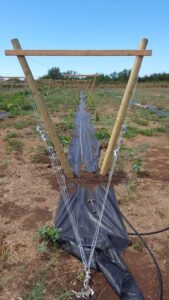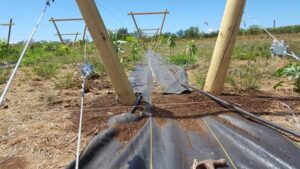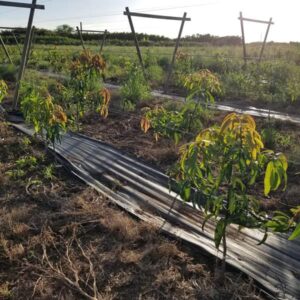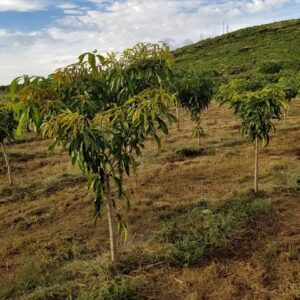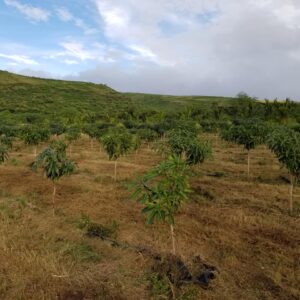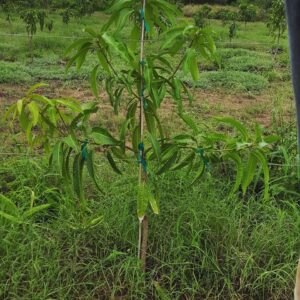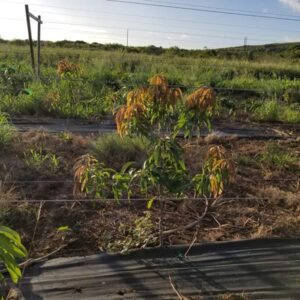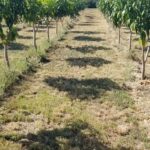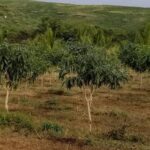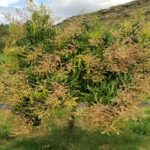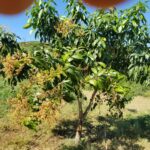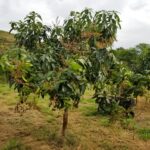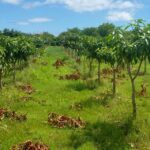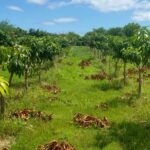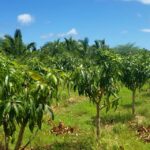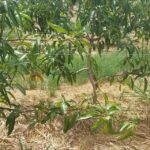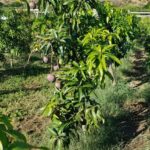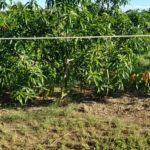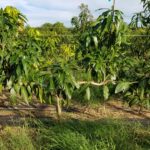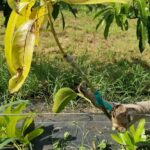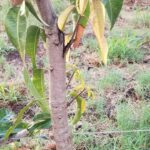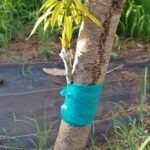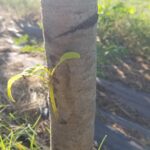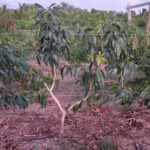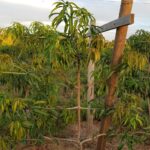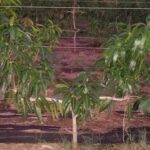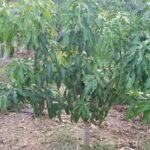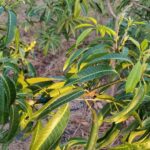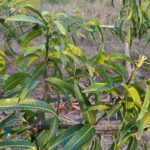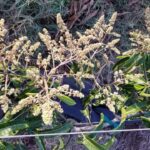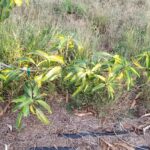Final report for FW17-034
Project Information
Improving Hawaii's mango industry by introducing and comparing two innovative techniques that have increased the yield and quality of fruit production, while improving on efficiency and management of the orchard. This project demonstrates the ultra high density plantation (UHDP) technique on a half acre field with 310 trees (10 rows with 31 trees) and the open Tatura trellis system on a 1/2 acre field with 300 trees (five rows of trellis with 60 trees per row). This project evaluates the costs of installation per acre, the advantages and disadvantages of these systems versus the standard methods, the expected return on investment, potential increase of production, labor demands, and orchard management.
The objective of the Mango Loa project is to improve the yield and quality of Hawaii's mango industry by demonstrating and comparing two new innovative orchard management systems for tropical fruits, these are the ultra high density plantation and the open Tatura trellis system. This project will cover the first three years, beginning with the installation following up with the pruning and training demands leading up to the start of production at three to four years.
The mango tree is a sub-tropical evergreen tree that is widely dispersed throughout the tropics. The trees are long lived, often over 100 years while still producing fruit. If left unpruned, trees will grow between 60 and 100 feet tall in 25 years. Traditionally, mango orchards were planted at a density of 50 trees per acre, with a spacing of 25 feet by 25 feet. Orchard maintenance is difficult and labor intensive. Pruning requires climbing trees, tall ladders, and pole saws, which increases the hazards on the job and the cost of production. Another method of pruning utilizes a tractor attachment with rotating blades which allows for mechanical pruning; this method is very fast and efficient, but also very cost prohibitive, limiting its use to large commercial orchards. Harvesting requires long pickers that often causes blemishes on the fruit and is prone to knocking down adjacent fruits. Mechanical lifts are utilized to facilitate harvesting and pruning, but again this equipment is expensive and only used by large orchards. Canopy maintenance is limited and pest and disease management is very difficult. Maintaining the ground cover and weeds is time consuming. The standard mango orchard takes seven to ten years for the trees to reach maximum production. All of these things add up to a lower quality fruit, a greater cost of production, and a longer wait for the orchard to to reach maximum production. A realistic expectation for mango production is two to five tons per acre, and the Food and Agriculture Organization (FAO) report the global average for mango production at 3.5 tons/acre.
The ultra high density plantation (UHDP) method has been in use for around a decade. Where it was first developed is hard to pinpoint, but India, Australia, Israel, South Africa, and China are a few of the countries that utilize this method for mango production. Planting densities over 300 trees per acre is considered ultra high density. UHDP is very similar to the standard mango orchard except that ten times the amount of trees are planted in the same area. The idea behind the increased density and the short trees is to lessen the demand on labor, while maximizing the use of available land and resources. All work is done from the ground, everything is done with simple hand tools, and in India they say that one person can manage up to 10 acres by his or herself. Through trials done in India and Australia, we know that mango trees thrive under heavy pruning and aside from lessening the demand on labor, there was also an increase in yield and quality of the fruit, increasing production to 8 to 12 tons per acre, while shortening the time to maximum production from 7 to 10 years to 3 to 4 years.
The Tatura trellis system has been around for about 30 years and was developed at the Tatura research institute in Victoria, Australia, with the goal of improving productivity and sustainability of temperate zoned fruits and through trial and error the trellises were a success and the practice has been accepted worldwide. In 2006, farmers in North Queensland, the tropical area of Australia, began adapting the trellis to tropical fruits to try and protect their orchards from severe storms, after a tropical cyclone had devastated the fruit orchards in the area. Then, in 2011, Tropical cyclone Yasi, a very large cyclone, hit North Queensland again, but this time, the trees that were on trellises survived. Since then, Australia has dedicated a lot towards research and trials to improve and adapt the open Tatura trellis system for tropical fruits.
Cooperators
- - Technical Advisor (Educator and Researcher)
Research
Year one began by starting 600 seedlings of "common" mango. This mango is polyembrionic, meaning one seed will produce between one and ten seedlings. Polyembrionic seeds are also clonal, in that they are identical, which will give the orchard uniformity because all the seedlings are the same. "Common" mango seedlings take from 10 to 18 months to get big enough for grafting. Six varieties were selected for propagation; four commercial varieties (Rapoza, Nam Doc Mai, Kiett, and Manzanillo) and two local varieties (Haden and Pirie). Grafting was used for propagation; cleft grafting was used if the scion wood matched the rootstock and side grafting was used if they were different sizes. Both methods produced excellent results. Grafting began after the flowering season, which in Hawaii is about March, and continued from March to September, until there was 350 grafted mango trees. Here is a video on grafting mangoes.
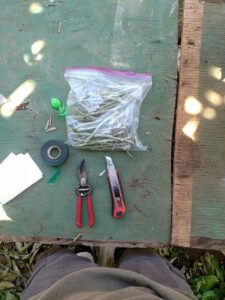
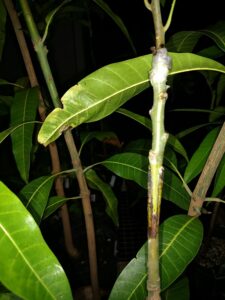
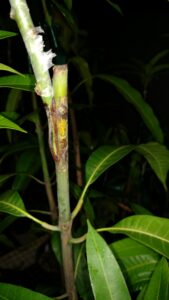
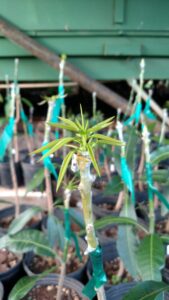


Field preparation began by hiring a bulldozer to clear the field of brush and grass. next, the field was laid out with ten rows and thirty trees per row at an 8' x 10' spacing, each row is 250' long. A mini excavator was used to dig the holes at 2' x 2' width and depth. The next step was to back fill the holes adding a half pound of 16-16-16 and half pound of neem cake to each hole. Once a row was back filled, 1/2" black tubing was laid down and covered with three foot wide black ground cover.
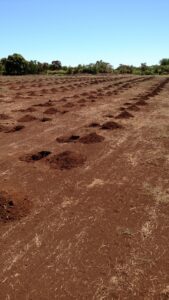
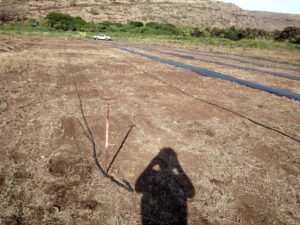
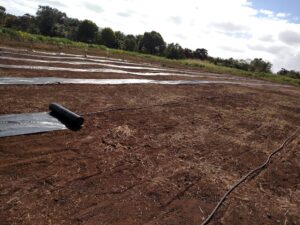
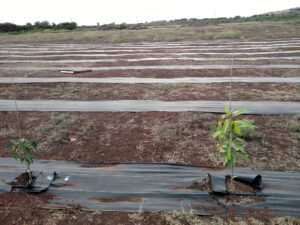
With the field prepped and laid out, it is time to start planting. I began by planting all four sides, then I planted a row in the middle to use as site points to try to line up the trees. I am currently half way through planting the field.
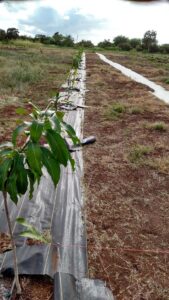
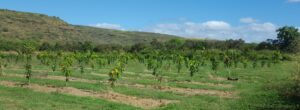
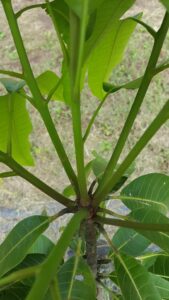
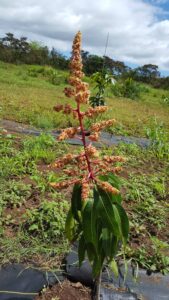
The end result of the field planting was 10 rows with 31 trees per row, here is a video of the uhdp field at one year. The primary
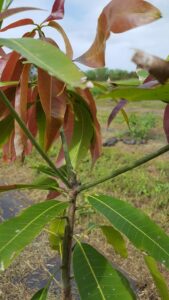
responsibility over the next year is to train and prune the trees to get the desired shape. The first goal is to set a single trunk at 30 to 36 inches. Trees are staked up as needed and flowers are removed so the trees can focus on vegetative growth. Suckers appearing below the graft point or out of place are removed as soon as possible. At this point the tree will flush with new growth and this must be thinned to two, three, or four shoots that will be trained to establish the scaffold branches. The scaffold branches will provide the main shape and support for the canopy. As the scaffold branches are forming it is important to choose branches that are evenly spaced at a 45 degree angle. if the branch is to horizontal it will bend down to the ground when set with fruit or it will not be able to support the weight and break. The branch will then flush new growth, after the third flush it should be between 18 inches to 30 inches. At this point, the terminal bud is removed, which will force multiple buds to flush, thickening the canopy. This brings the height of the tree to five feet. the most developed trees in this field are now at this stage. The majority of time is spent maintaining the ground cover and weeding around the trees, walking the field, pruning and training branches.
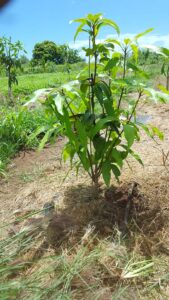
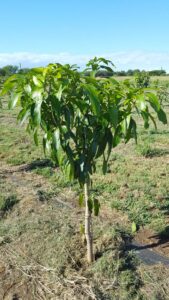
Open Tatura Trellis System
Year two. This year's planting incorporated all the same components of the stand alone UHDP field, with one added element, the open Tatura trellis system. Five rows have been laid out, each row has 240 feet of trellis to plant on, with two lines of 1/2 inch poly tubing and 2 gallon/hour drip emitters every 8 feet, one emitter per tree. This is overlaid with three feet wide black weed mat. The open tatura trellis system is planted in staggered double rows 20 inches apart. Trees are planted 8 feet apart in rows while being trained up the trellis. Each row of trellis has 30 trees on each side, with 60 trees per row times 5 rows for a total of 300 trees on a 1/2 acre field, here is a video.

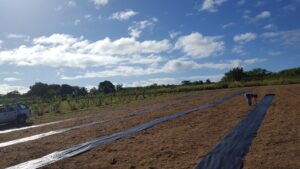
Ground anchors
Each row of trellis is 260 feet long from anchor to anchor. Ground anchors are required for each end of the rows that will be the main support for carrying the weight of the trees and fruit to come. The anchors should be set an equal distance away from the post as it is tall, so my posts are 8 feet tall and the anchors are set 8 feet away from the post. There are many different designs for ground anchors; from large screw shaped rods that are drilled in the ground or a flat steel plate attached to a rod and buried three feet deep. For this project, the ground anchors were made out of concrete and chain. Each hole was dug 36 inches deep by 20 inches long by 8 inches wide. A wire basket was made with concrete mesh and a 12 inch piece of 5/8 inch rebar with 5/8 inch by four feet long chain attached and placed within the basket to add strength to the concrete. Two bags of 80 pound Quickcrete was used per hole.
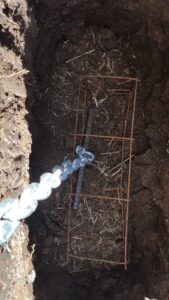
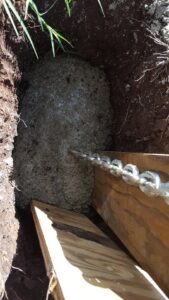
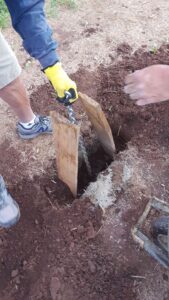
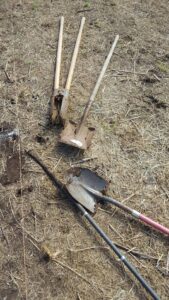
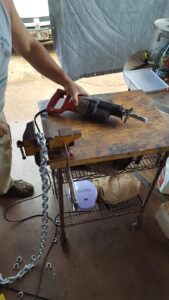
Treated Pine Wood Posts

The open tatura trellis system is a "V" style trellis with a 20 inch "open" gap between posts, this is an adaptation from the original design, and it allows the farmer to walk in between the rows. The posts are set at a 72 degree angle, which has been determined to be the best angle for optimal light interception, or the percentage of light that is absorbed by the canopy of the tree, from the bottom of the tree to the top. Seven pairs of treated pine posts were used for each row. 5" by 10' posts and 3 1/2" by 10' posts were alternated in each row and set 40 feet apart. 45 feet should be the maximum span between posts. Posts were set 24 inches deep, with the tops of the posts being eight feet above the ground. The post holes were dug with a gas powered ground drill and that was essential for the job, hand digging the holes would be very labor and time intensive. Making a template to follow when auguring the holes is essential to getting the right angle when setting the posts. 2" x 4" x 8' cross pieces were added to the top of the posts for stabilization.

High Tensile 12 1/2 Gauge 200,000 psi Steel Wire
High tensile wire is stronger and resists stretching like soft wire and is the preferred wire for trellises. The wire is coiled under tension, so a Spinning Jenny is required to dispense the wire. Five rows of wire were attached to the posts from the ground up. 1 3/4 inch barbed staples were used to attach the wire to the posts. The first wire was set 24 inches from the ground and 18 inches apart between wires. One end of the wire was attached directly to the chain on the ground anchor and the other end of the wire was attached to a wire strainer that is attached to the ground anchor and this is to tension the wire once all is set up.
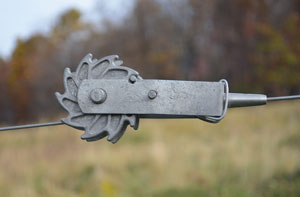
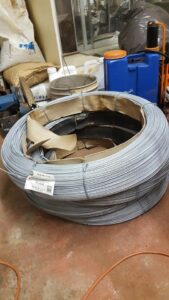
Pruning and Training
Ultra high density field. The first year of pruning and training was focused on developing the main trunk and the scaffold branches that provide the main structure and support of the tree. Year one pruning was fast and easy, taking 0 to 30 seconds per tree or 2 to 3 hours to prune the entire field. Pruning is required every two months and it is important to keep up with each flush of new leaves and growth. At the end of year one, the trees were 4 to 6 feet tall, the main trunk and scaffold branches are developed and the canopy of the tree is beginning to fill in.
Year two, the main focus was developing the canopy of the tree by constantly pruning and tipping, this encourages branching and spreading out. Here is where it is very important to keep up with every flush of new growth. If you miss pruning a flush of growth and there is a second flush, you will have to prune back two sections. This will set you back about two months of growing time and if you don't prune back two sections, the tree will get too tall. Pruning in the second year was a lot more intensive, taking 1 to 3 minutes per tree or 6 to 8 hours for the entire field, 4 to 6 times per year. At this stage flowers are removed as soon as possible to keep the tree focused on growing wood and leaves. The work is easy, but it takes time to selectively prune and thin out new growth. Here is a video on the uhdp field after the second year, and here.
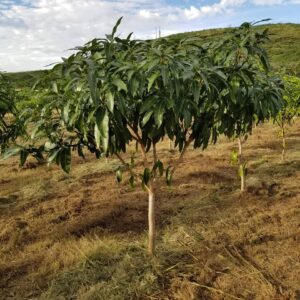
Open Tatura trellis field. Mango trees are vigorous upward growing trees. Pruning and training begins immediately. The first wire on the trellis is 24 inches from the ground. The first pruning is at the height of or a couple inches below the first wire, if the tree has not branched out yet. Some of the work can be started in the nursery. When grafting trees, it becomes essential to have the graft point below 18 inches, preferably lower, or the tree will be too tall to get the branches trained along the first wire. If you miss the first wire, 20% of the growing space is lost, so this is very important.
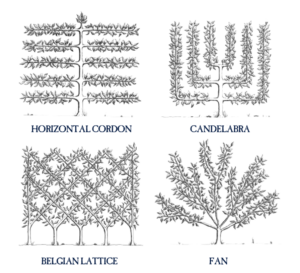
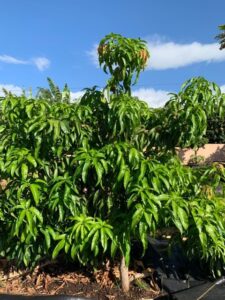
There are many different ways to train trees along a trellis. For this field, the primary design is the Horizontal Cordon, or the central leader. The leader is very important to this style. establishing the leader will reduce the vigor in the other branches. If there is no established leader, all the other branches will compete to become the dominant leader and this will increase the vigor in the whole tree making it difficult to manage. With the Espalier style a central leader is established that grows up, while a single branch is trained laterally or horizontally along the wire on each side of the leader. Each lateral growing branch has a four feet span to cover. When the leader reaches the next wire, it is topped, and with the new growth, a new leader is established and again branches are trained to grow laterally on each side of the leader, all other branches are removed. As the branch grows laterally, the terminal bud is removed, when the branch flushes new growth, there will be 2 to 10 new branches, one branch will be selected to be the primary lateral growing branch, while one or two other shoots are left to form the sub-lateral branches, all other shoots are removed. The sub-lateral branches are established with each new flush, every 6 to 10 inches, and this is where most of the flowers and subsequent fruit will develop. Sub-lateral branches should be growing up not down, especially on the bottom wire, if it is pointing down the flowers and fruits will be on the ground. It is the sub-lateral branches that are pruned back each year to maintain the tree with in its space. Training and pruning the trees along the trellis took three to five minutes per tree, with most of the time used tying the branches to the wire.

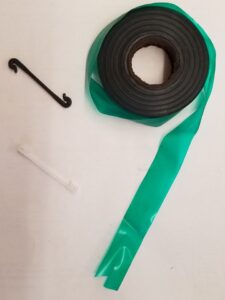


Year Three : Ultra High Density Plantation (UHDP) The uhdp field was planted between November 2017 to May 2018, so the trees have been in the ground from 30 to 36 months. At this point, 200 trees are at the desired height and size and are ready to bear fruit; another 50 trees are shorter or have a less developed canopy, but are still going to be allowed to flower and fruit; and another 50 trees are not ready to bear fruit. The trees that are not ready for fruiting are younger trees that have replaced dead trees, or have been damaged and need to regrow its' canopy. The trees that are full size are now managed according to its' growth cycle. One major pruning, to reduce the size of the tree is conducted directly following harvest. It takes 5 to 6 minutes per tree to prune and tip and this is an opportunity to apply nutrients. Mango trees have a short dormancy, usually in early winter, followed by a flush of flowers. This is another moment to apply nutrients important to flowering and fruiting, and fungicides to protect against Powdery mildew and Anthracnose. Harvest begins in the Summer through the Fall depending on the variety or when it flowered, and takes 6 to 8 weeks. Here is a video on the third year, and here.
Open Tatura Trellis System (OTTS)
The otts field was planted from January to April 2019 and the trees have been in the ground for 20 to 24 months. The focus over the last 12 months has been to continue training the branches laterally onto the trellis wires and establishing sub-lateral branches, which is where the majority of flowers come from. There are mainly four varieties in the field; white pirie (180), Nom dok mai (60), Keitt (50), Rapoza (10). Aside from Nom dok mai, a semi-dwarf tree, most of the trees have reached the fourth wire and have completely filled in the first two wires laterally. It is expected that most of the trees will have filled in the entire trellis by the end of the third year. At least half the trees are flowering.
Pruning and training is required every two to three month while training onto the trellis and takes 2 to 5 minutes per tree. the proper tools will speed up the work.

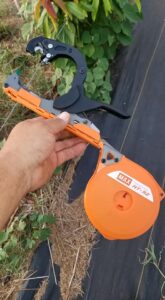
If the graft point on the tree is too high or if you break a branch trying to bend it too much, there is a chance that the bottom wire will be left unused. to remedy this, you can graft on a scion branch to replace the missing one. this can be done by grafting onto new shoots or directly onto the trunk. if the graft union is below the wire but there is not branch to attach to the wire, it is possible to notch or cincture the trunk to force a shoot to emerge. If the new shoot emerges above the graft point, then you can start to train it onto the wire; if the shoot emerges below the graft, then graft on the variety you want to train along the wire.
Different varieties have different growth habits. Some trees, like White pirie, often flushes new leaves with a whorl of shoots, anywhere from 2 to 10 shoots. This allows you to train the trees vertically and laterally at the same time and will fill in the space quicker. Keitt is a vigorous upright growing tree that flushes off of the terminal shoot and doesn't have the whorl of shoots. because of this, you have to train the lateral growth independently from the vertical growth by removing the terminal shoot to force the whorl of shoots to emerge. This will take longer to train the trees. Nom dok mai is a small slow growing tree, growing at half the rate of the other trees. The branch nodes are thicker, less pliable, and will break if forced to go where it doesn't want to. Training this tree into the fan shape is more natural than the central leader design, with less time loss trying to replace broken branches.
Developing lateral growth and sub-lateral growth: Each flush of shoots will need to be thinned out with one shoot being the lateral leader, either the terminal shoot or a selected one, and two or three sub-lateral shoots. Sub-laterals on the bottom wire need to be facing up or the flowers will bloom on the ground. Other wires can have sub-laterals facing down if there is room.
3 to 1 rule. The three to one rule says; the selected shoot to grow laterally along the wire should be 1/3 the size of the main trunk. This is easier said than done, but it is a good rule to follow. It is usually best to cull the most vigorous shoots and branches because they will compete for dominance with the leader, increasing the overall vigor of the tree. The diagram of the tree showing the central leader shape and different ways the laterals grow out. the bottom left lateral branch shows optimum development, except for the downward pointing shoot, with sub-laterals every few inches providing lots of flowering wood. The lateral third up from the bottom is an example of a lateral branch that grew out without any sub-lateral development. Some mango varieties will only flush from the terminal bud and wont have any side shoots, these trees need to be pruned at every flush to ensure adequate sub-lateral development.
| UHDP materials/ acre | |
| Field | $4,147 |
| Nursery | $1,563 |
| Small tools | $374 |
| Total | $6,084 |
| Trees | $16,500 |
| UHDP+Trees | $22,584 |
| Open Tatura Trellis | $6,878 |
| Trellis+UHDP | $12,962 |
| Trellis+UHDP+Trees | $29,462 |
When examining the cost for the materials needed to install one acre of mango using ultra high density plantation (UHDP)methods, it comes to $6,084. Hawaii doesn't have a good resource for grafted trees, wholesale trees from nurseries range from $30 to $50, and with 600 trees per acre that comes out to $16,500 for the trees alone, bringing the installation cost to $22,584 per acre. The materials for the trellis add about $7,000 per acre. The cost for the materials needed to make your own grafted trees come up to around $2.80 per tree and the 18 months process it takes to grow, graft, and plant the trees, so there is real incentive to raising and grafting your own trees. In Hawaii, mangoes sell for $1.00/lb to $3.50/lb, depending on the season, making it a reasonable expectation to gross $20,000 per acre.
The Ultra High Density Plantation (UHDP) and the Open Tatura Trellis System (OTTS)
Cost of Installation- The most obvious difference between these two techniques is the cost of installation. The materials for the trellis cost about $7,000 per acre, which can be very cost prohibitive, especially when considering planting 10 acres or more. However the shorter time to production and the higher yields will allow for a quicker and greater return on the investment over the standard orchard system.
Orchard management- An aspect of these two techniques is to lessen the demand on labor, while in India, using the uhdp method, they say that one person can manage up to 10 acres, this can be done if you put in 60 hours a week, and I don't doubt there are farmers who do that. The uhdp field, in the first two years of pruning and training has been fast and easy. The trees take 0 to 1 minute to prune and the entire 1/2 acre can be completed in two to three hours. However, by the end of the second year, the trees are between four and six feet tall and the canopy is filling out. The trees are nearly the desired size and pruning takes three to four minutes per tree, now it takes nearly six hours to prune the whole field. The otts field has been the opposite, establishing the trees along the wire is a lot more time consuming in its' first year. Pruning and training the trees on the trellis in the first year requires three to five minutes per tree, or about two hours per row, 10 hours for the entire field. This is substantially more time than the uhdp field, where most of the time difference is from tying down branches to the wire. Pruning the uhdp field requires a little more thought and strategy, because of the importance of branch placement as well as optimal angles for best support. Whereas, the otts training is along the wire, the pattern has already been determined, just have to do the work tying down branches. The uhdp field requires stakes for the trees, in the first year or two, and when there are 600 trees per acre, it can get expensive. However, thicker stakes could be gathered from the wild for the second year, and by the third year no stakes were required. The otts field uses a lot of trellis clips and vinyl tape for training the trees along the trellis, which is another costs that adds up when dealing with 600 trees per acre. But, once the tree fills in the space on the trellis, no more trellis clips are required. Use of a Tapener to tie down branches significantly reduced the time spent training per tree and reduced excessive use of vinyl tape. I believe the difference between these two systems, in the time it takes to prune and train the trees, will be less once the trees reach full size in the field and on the trellis. At this point, it is tying the trees onto the wire that is most time consuming, and by the third year, training will be done, and pruning will be for excessive growth and sub-laterals. Pruning in these two systems is more time consuming and labor intensive, over the first three years, than pruning in the standard mango orchard. This is simply because of the number of trees in the high density systems, 600 trees per acre versus 50 trees per acre. However, that time and effort is made up when it comes to harvesting the low trees, which is done from the ground and picked by hand. In essence, it's a trade off in the demand on labor between pruning and harvesting.
Optimal light interception and light distribution- Increased production using these systems is attributed in large part to light interception, or the percentage of sunlight that is captured by the orchard canopy, as opposed to the orchard floor which does nothing for fruit development. Sunlight is the fuel behind fruit production and when light interception reaches 65% to 75%, yields increase, the fruit is sweeter, and coloring is improved. Light distribution is the amount of light that penetrates into the canopy of the tree. A full size mango tree has a 20 to 30 foot canopy. Sunlight can penetrate about 3 feet into the canopy; one third of the canopy will have optimal light interception, one third will have adequate sunlight, and one third will be unproductive. With the uhdp system and the small trees, light can penetrate throughout the entire canopy leaving no unproductive space, and the same effect occurs with the trellis system.
Reduced time to maximum production- In the standard mango orchard, it will take the trees 7 to 10 years to reach full production. with fifty trees per acre, it will take that time for the canopy to reach optimal light interception. For the high density systems at 600 trees per acre, it will take 3 to 5 years for the orchard canopy to fill in and reach its maximum production, a considerable reduction in wait time.
Netting and covers- High density orchard management systems and the short trees allow for the farmer to cover the orchard with netting to keep out unwanted pests; fruit flies, birds, rats, and numerous other critters that decrease production. Another possibility is to cover the rows with tarp to force a drought, this will induce flowering in some tropical fruit trees, namely durian and lychee. Protecting crops from sunburn using a covering is becoming more common as we experience increased temperatures. Being able to manipulate flowering to increase production and covering crops with netting for pest control and sun protection are important benefits of these systems.
Mechanization/ Robotics- Hawaii has always had a small population, therefore a labor shortage for agriculture workers. The sugar plantations hired contract workers from all over the world to meet their labor demands. Even today, contract workers are brought in for commercial fishing, seed corn production, coffee harvesting, and other vegetable production. High density orchard systems have the ability to adapt to mechanization and robotics, allowing farms to scale up and still meet the labor demands . Uhdp, with straight rows and low trees can easily incorporate mechanical pruning. Robotics, to facilitate harvesting and pruning of grapes can be adapted for the open Tatura trellis system. Australia has developed a robotic harvester for mangoes that are going to be processed.
Open Tatura Trellis (OTTS)- The V-trellis, with the posts at a 72 degree angle, creates a flat 2-dimentional canopy. This effect allows for sunlight to reach every branch of the tree from the bottom to the top, having optimal light interception throughout. This "V" design and the double rows can fit more trees per acre, when compared against the Espalier style trellis. These things attribute to the increased production using this system. However, the difference in the cost of this system versus uhdp is significant to the point of being cost prohibitive. When we have the data to compare the production of these two systems, we will have a better understanding on whether it is worth the additional costs of the trellis, specifically for mango. The trellis system has been adapted to many different tropical fruits and have been producing great results, but not all trees will thrive on the trellis, more trials are need to be conducted to get more information.
Research outcomes
Education and Outreach
Participation summary:
Year 1. The most useful outreach tool at this point has been Facebook, where I created a group "The Mango Loa Project", and have been chronicling its' progress. There is a good number of Hawaii farmers following along with a lot of interest. Through the group, I have also been able to reach people all over the world. I have been in contact with people from Florida and Arizona, India, Thailand, and Australia about my project and the movement towards ultra high density. This year's Hawaii Tropical Fruit Growers state conference's main theme was high density and trellising tropical fruits. This was another great opportunity to meet farmers throughout the state, where I was able to display a poster of the project and talk about the things I've been doing. There is a lot of interest for high density planting and at the moment my project is the largest trial in the islands. I had my first field day in May, where I presented my project and hosted a grafting workshop to 25 attendees, which for Kauai Island is a pretty large number. A fact sheet was distributed at this event. I also had two visits to the local high school's agriculture program, where I did a grafting workshop with the students as well as a discussion on sustainable agriculture and pruning fruit trees for small spaces. Sadly, two events scheduled last year were canceled due to the severe flooding on the North side of the island that forced the cancellation of the mango festival and a scheduling conflict interfered with the Kauai farm and garden fair. I am currently scheduled to be a presenter at both events later this year. It is a little hard to have regular farm events and to get farmers to show up, but I have been able to visit three farms and consult with farmers about planting new fields using ultra high density plantation (UHDP) techniques. My next field day is scheduled for the end of January , where the topics will be UHDP year two and the most important tasks and a demonstration on the open tatura trellis system (OTTS); there is a lot of interest on this topic. I expect there to be more participation at this event because this is the direction that Hawaii's tropical fruit farmers are heading and Kauai doesn't have an open tatura demonstration on the island. The one event I attended that was a discussion on the topic showed that a good number of farmers want to incorporate these techniques on their farms, but need to see more examples before they commit to the financial investment of planting orchards using UHDP and open tatura trellis systems. Once this year's field is planted I will have the data needed to do a detailed cost analysis of the UHDP vs. open tatura trellis system vs. traditional orchard layout. A power point presentation is in the works and will be a guide to UHDP techniques and OTTS, a how to presentation that will be made at this year's annual garden fair and mango Festival. This year I am opening up my farm to the nonprofit organization GoFarm Hawaii; this group trains aspiring farmers in the classroom and field. They visit farms to volunteer and get hands on experience, this year my farm will be one of the participating farms.
Year 2. We had one field day this year, we went over the ultra high density field and the pruning and training requirements necessary over the first full year. We also demonstrated the open Tatura trellis field, going over the installation of the trellises and the basics of the open Tatura trellis system. There was 28 participants for this field day, with over half being farmers. We had 8 tours throughout the year. Most of the tours were for individual farmers that were from other islands and visiting Kauai; two farmers from Oahu, one farmer from Maui, and two farmers from Hawaii island. One tour was with a local high school's agriculture program and one group was a mix of people from USDA and NRCS. I did an interview for KKCR Kauai community radio, talking about the mango loa project and the advantages of high density fruit farming. I attended two conferences; the Hawaii tropical fruit growers conference in Kona, where I displayed my project as well as talked about high density farming; and the Hawaii agriculture conference on Oahu, where I did a Power Point presentation with the topic of "Hawaii's Fruitful Future" to talk about how we can improve Hawaii's tropical fruit industry. I had a booth at the local Waipa Mango Festival where i displayed posters and talked about the project. I started a You tube channel, The Mango Loa Project, and have uploaded 6 videos that go over the ultra high density plantation and the open Tatura trellis system. My videos have 6,000 views over the last 6 months. I consulted with one farmer at his farm and helped install one row of trellis. I also consulted with two farmers in Florida, on the phone and email, one on the installation of the open Tatura trellis system and one on implementing the ultra high density plantation system.
Year 3- This Covid year saw a lot of cancelled in person events, but opened up opportunities for online webinars, which I probably would never have done if not for this year. I participated in three online Zoom events this year. One event, put on by the Hawaii Agriculture Research Center (HARC) on Oahu, featured one of the pioneers of trellising tropical fruits, Peter Salleras, who has become my mentor over the last 3 years. This was supposed to be an in person event that was cancelled and adapted online. Another Zoom event I was invited to as a speaker was put on by Hawaii's farmers union, Maui chapter, on the open Tatura trellis system. Farmers here are very enthusiastic about adapting to the open Tatura trellis system. The final online event was my own, on the Mango loa project, and was a PowerPoint presentation on what I learned about high density orchard management systems. https://youtu.be/jEvLzG85fZI There were 120 individuals registered for the event, 66 participants logged in to the event, and 42 participants was the highest number logged in at one time.
taturafactsheet Here is a quick guide to installing an open Tatura trellis.
Three new videos documenting this years growth were made and uploaded to the mango loa project YouTube playlist, for a total of 10 videos. https://youtube.com/playlist?list=PLuxS09DD2F-Igs5LUsz0tIl9myXQc6H7_ At this point the youtube videos have nearly 33,000 views and 512 subscribers to the channel.
I had three different one on one tours on the farm and four consultations on the phone or online about the open Tatura trellis system. I also maintain the Facebook group "The Mango Loa Project" https://www.facebook.com/groups/139225416768328, where I post pictures on the progress and is a point of contact for questions.
Education and Outreach Outcomes
The main limitation of this project is that it is a three year project and it will not get into the production phase of the orchard. Because of that, the focus is mainly on the cost of production, installation of these two techniques, and the demand on labor to implement these orchard management styles. However, There will always be skeptics to major changes and a lot of farmers are waiting to see what the production is like before they will commit the time and money to change over to a new system. In order to get the most from this project, it will need a second part, the first three years of production. If we can extend the project for another three years that will show production, we will be able to evaluate the yields and quality of fruit these two systems produce. This will go a long way in producing a comprehensive report of the ultra high density plantation and the open Tatura trellis systems.
Another very important aspect of improving the fruit quality is post-harvest practices. The importance in improving the quality of our fruit production is to gain the trust of the fruit distributors. They need to be confident that the supply is there, the fruit is excellent quality in looks and taste, and it has been handled in a way to maximize its' shelf life. So, the next step after improving production is the ability to pick, wash, and store the mangoes to preserve its' shelf life. For mangoes this involves picking fruit in cooler temperatures, neutralizing the sap to prevent sap-burn, washing and packing, and cool storage. Developing protocols for post harvest treatment and storage of mangoes will go a long way towards advancing our tropical fruit industry.
We need more trials. This project was focused on mangoes, but here in Hawaii we can grow all tropical fruits and these two systems have increased the production with other fruits. Using UHDP methods have had great results for guava, jackfruit, and breadfruit, while the open Tatura trellis system has had excellent results in growing durian, sour sop, litchi, starfruit, and abiu; all excellent fruits that have growing markets.
Irrigation/ Fertigation
Training and pruning
understanding ultra high density
Open Tatura Trellis System and the benefits
